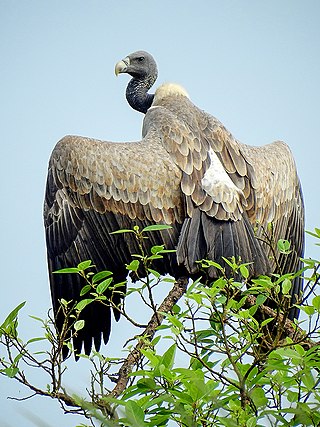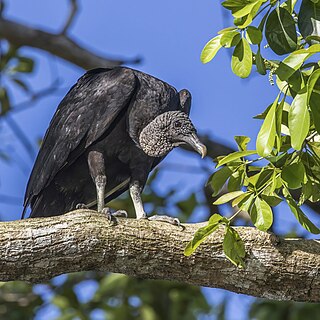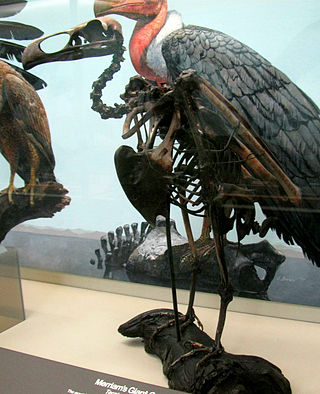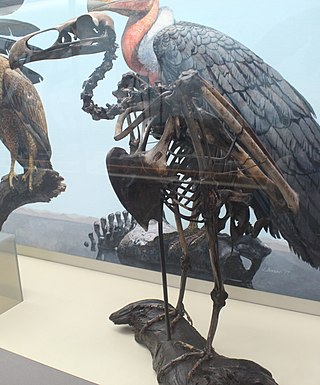
A vulture is a bird of prey that scavenges on carrion. There are 23 extant species of vulture. Old World vultures include 16 living species native to Europe, Africa, and Asia; New World vultures are restricted to North and South America and consist of seven identified species, all belonging to the Cathartidae family. A particular characteristic of many vultures is a bald, unfeathered head. This bare skin is thought to keep the head clean when feeding, and also plays an important role in thermoregulation.

Birds of prey or predatory birds, also known as raptors, are hypercarnivorous bird species that actively hunt and feed on other vertebrates. In addition to speed and strength, these predators have keen eyesight for detecting prey from a distance or during flight, strong feet with sharp talons for grasping or killing prey, and powerful, curved beaks for tearing off flesh. Although predatory birds primarily hunt live prey, many species also scavenge and eat carrion.

Haast's eagle is an extinct species of eagle that lived in the South Island of New Zealand, commonly accepted to be the pouākai of Māori mythology. It is the largest eagle known to have existed, with an estimated weight of 10–18 kilograms, compared to the next-largest and extant harpy eagle, at up to 9 kg (20 lb). Its massive size is explained as an evolutionary response to the size of its prey—the flightless moa—the largest of which could weigh 200 kg (440 lb). Haast's eagle became extinct around 1445, following the arrival of the Māori, who hunted moa to extinction, introduced the Polynesian rat, and destroyed large tracts of forest by fire.

The Accipitridae is one of the three families within the order Accipitriformes, and is a family of small to large birds of prey with strongly hooked bills and variable morphology based on diet. They feed on a range of prey items from insects to medium-sized mammals, with a number feeding on carrion and a few feeding on fruit. The Accipitridae have a cosmopolitan distribution, being found on all the world's continents and a number of oceanic island groups. Some species are migratory. The family contains 255 species which are divided into 70 genera.

The Indian vulture or long-billed vulture is a bird of prey native to the Indian subcontinent. It is an Old World vulture belonging to the family of Accipitridae. It is a medium-sized vulture with a small, semi-bald head with little feathers, long beak, and wide dark colored wings. It breeds mainly on small cliffs and hilly crags in central India and south India.

The hooded vulture is an Old World vulture in the order Accipitriformes, which also includes eagles, kites, buzzards and hawks. It is the only member of the genus Necrosyrtes, which is sister to the larger Gyps genus, both of which are a part of the Aegypiinae subfamily of Old World vultures. It is native to sub-Saharan Africa, where it has a widespread distribution with populations in southern, East and West Africa. It is a scruffy-looking, small vulture with dark brown plumage, a long thin bill, bare crown, face and fore-neck, and a downy nape and hind-neck. Its face is usually a light red colour. It typically scavenges on carcasses of wildlife and domestic animals. Although it remains a common species with a stable population in the lower region of Casamance, some areas of The Gambia, and Guinea-Bissau, other regions such as Dakar, Senegal, show more than 85% losses in population over the last 50 years. Threats include poisoning, hunting, loss of habitat and collisions with electricity infrastructure, and the International Union for Conservation of Nature has rated its conservation status as "critically endangered" in their latest assessment (2022). The highest current regional density of hooded vultures is in the western region of The Gambia.

The black vulture, also known as the American black vulture, Mexican vulture, zopilote, urubu, or gallinazo, is a bird in the New World vulture family whose range extends from the southeastern United States to Perú, Central Chile and Uruguay in South America. Although a common and widespread species, it has a somewhat more restricted distribution than its compatriot, the turkey vulture, which breeds well into Canada and all the way south to Tierra del Fuego. It is the only extant member of the genus Coragyps, which is in the family Cathartidae. Despite the similar name and appearance, this species is not closely related to the Eurasian black vulture, an Old World vulture, of the family Accipitridae. For ease of locating animal corpses, black vultures tend to inhabit relatively open areas with scattered trees, such as chaparral, in addition to subtropical forested areas and parts of the Brazilian pantanal.

Aegypiinae is one of two subfamilies of Accipitridae that are referred to as Old World vultures, the other being the Gypaetinae. They are not closely related to the Gypaetinae, and are instead a sister group to the serpent-eagles (Circaetinae).

Gyps is a genus of Old World vultures that was proposed by Marie Jules César Savigny in 1809. Its members are sometimes known as griffon vultures. Gyps vultures have a slim head, a long slender neck with downy feathers, and a ruff around the neck formed by long buoyant feathers. The crown of their big beaks is a little compressed, and their big dark nostrils are set transverse to the beak. They have six or seven wing feathers, of which the first is the shortest and the fourth the longest.

Thylacoleo is an extinct genus of carnivorous marsupials that lived in Australia from the late Pliocene to the Late Pleistocene, often known as marsupial lions. They were the largest and last members of the family Thylacoleonidae, occupying the position of apex predator within Australian ecosystems. The largest and last species, Thylacoleo carnifex, approached the weight of a lioness. The estimated average weight for the species ranges from 101 to 130 kg.

Aiolornis incredibilis is an extinct species of teratorn bird from the western United States. Only fragmentary remains have been found, which are dated between the Early Pliocene (Zanclean) and Late Pleistocene. First described as Teratornis incredibilis by Howard in 1952 based on a cuneiform bone, the species has been moved to the new genus Aiolornis by Campbell, Scott and Springer in 1999. The generic name is derived from the ancient Greek words aiolus and ornis. Aiolus refers to the Greek god of the wind, and ornis means "bird". The specific name incredibilis means 'incredible'. A. incredibilis is lesser-known than its close relative, Teratornis merriami, even though A. incredibilis was significantly larger. It presumably became extinct at the same time as the other megafauna in North America.

Teratornithidae is an extinct family of very large birds of prey that lived in North and South America from the Late Oligocene to Late Pleistocene. They include some of the largest known flying birds. It's members are known as teratorns.
The giant koala is an extinct arboreal marsupial which existed in Australia during the Pleistocene epoch. Phascolarctos stirtoni was about one-third larger than the contemporary koala, P. cinereus, and has an estimated weight of 13 kg (29 lb), which is the same weight as a large contemporary male koala.

Teratornis was a genus of huge North American birds of prey—the best-known of the teratorns—of which, two species are known to have existed: Teratornis merriami and Teratornis woodburnensis. A large number of fossil and subfossil bones, representing more than 100 individuals, have been found in locations in California, Oregon, southern Nevada, Arizona, and Florida, though most are from the Californian La Brea Tar Pits. All remains except one Early Pleistocene partial skeleton from the Leisey Shell Pit near Charlotte Harbor, Florida date from the Late Pleistocene, with the youngest remains dating from the Pleistocene–Holocene boundary.

Buteogallus is a genus of birds of prey in the family Accipitridae. All members of this genus are essentially neotropical, but the distribution of a single species extends slightly into the extreme southwestern United States. Many of the species are fond of large crustaceans and even patrol long stretches of shore or riverbank on foot where such prey abounds, but some have a rather different lifestyle. Unlike many other genera of raptor, some members are referred to as "hawks", and others as "eagles".
Buteogallus borrasi is a species of giant buteonine hawk which went extinct in the early Holocene. Formerly endemic to Cuba, this huge bird of prey probably fed on Pleistocene megafauna. Little is known about its appearance and ecology, so no common name has been given.
Buteogallus daggetti, occasionally called "Daggett's eagle" or the "walking eagle", is an extinct species of long-legged hawk which lived in southwest North America during the Pleistocene. Initially believed to be some sort of carrion-eating eagle, it was for some time placed in the distinct genus Wetmoregyps, named for Alexander Wetmore. It probably resembled a larger version of the modern-day savanna hawk, with its long legs possibly used like the secretarybird of Africa to hunt for small reptiles from a safe distance. It died out about 13,000 years ago.

Xenorhynchopsis is an extinct genus of flamingo from the Pliocene to Pleistocene Lake Eyre basin of Australia. Initially described as species of stork, the two known Xenorhynchopsis species are vastly different in size. X. minor is the older and small of the two species, ranging from the Pliocene to Pleistocene and being described as having reached a size smaller than that of the lesser flamingo. X. tibialis meanwhile appears to have been restricted to Pleistocene strata and was notably bigger, being counted as one of the biggest known flamingos in the fossil record.

Dynatoaetus is an extinct genus of large bird of prey from the Pleistocene of Australia. It is among the largest known raptors of the region, second only to the Haast's eagle of New Zealand, with estimates suggesting a weight of up to 12 kg (26 lb). Although most closely related to modern vultures, it shows clear adaptations towards an active predatory lifestyle in the form of robust, powerful talons. This may either hint at it retaining these ancestral features from the closely related serpent eagles or show that it convergently evolved these features as it took on a similar lifestyle. Due to their size and robust bones, it is thought that Dynatoaetus would have been capable of taking large prey items like kangaroos, giant wombats and flightless birds. There are two species within the genus, the type species Dynatoaetus gaffae and the somewhat smaller Dynatoaetus pachyosteus, both of which inhabited the same part of Australia at the same time.
















